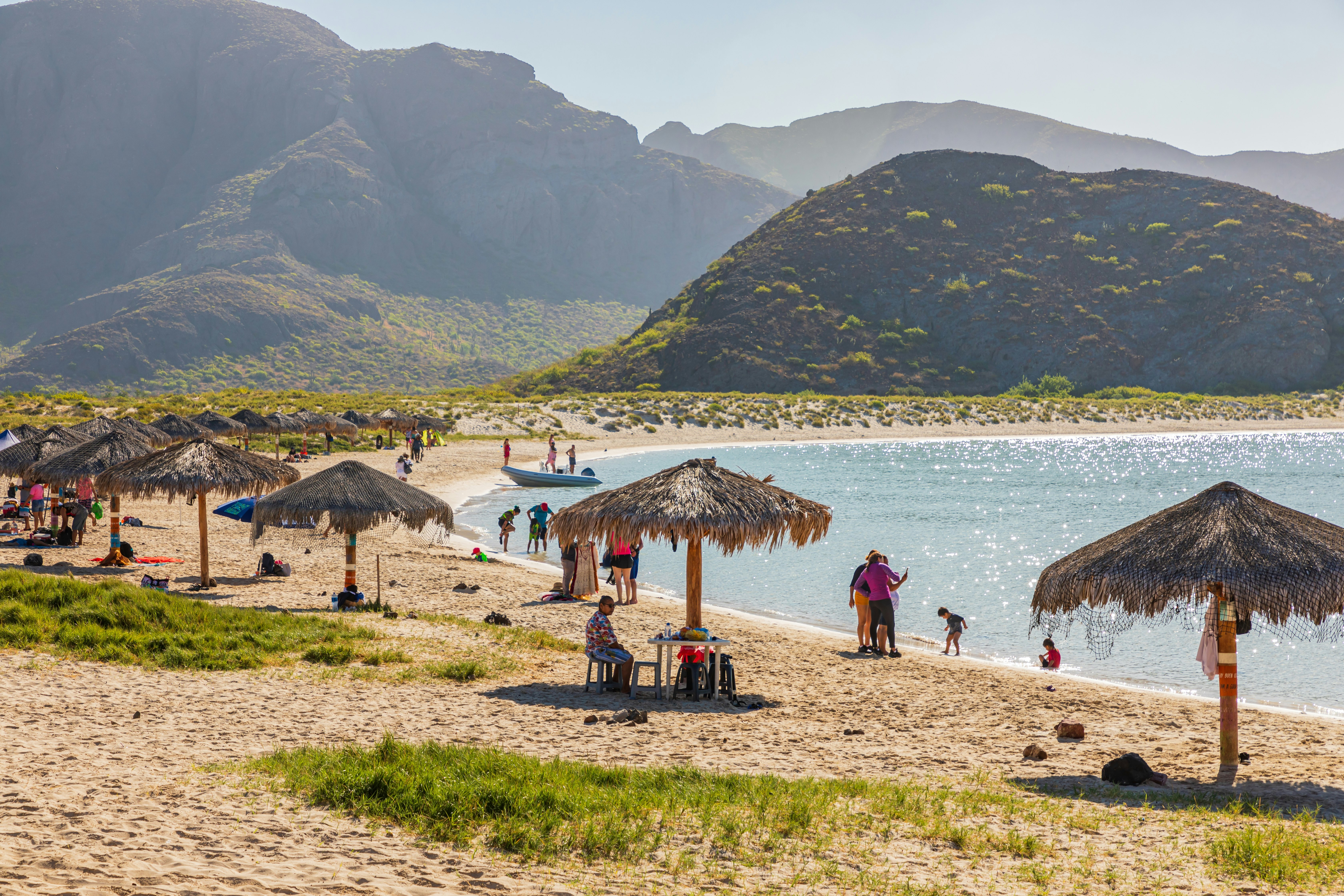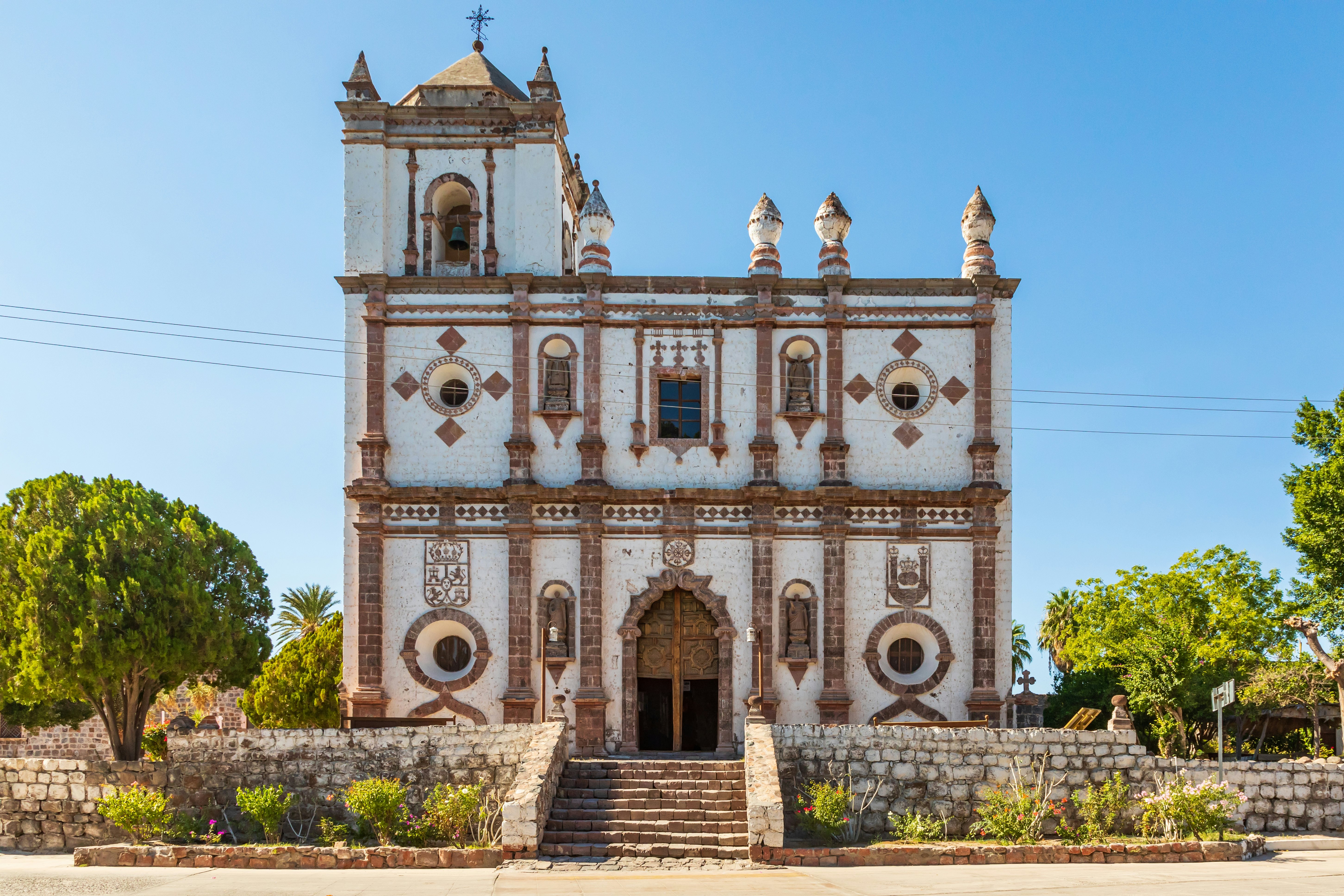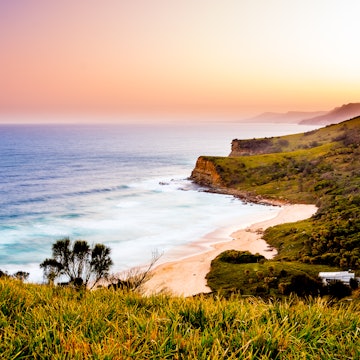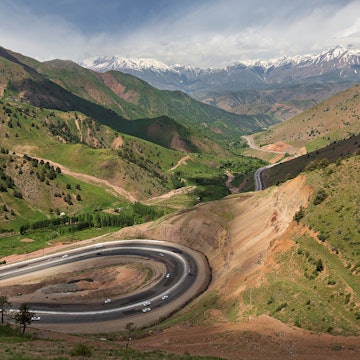
Baja in 10 days: The ultimate road trip from Cabo to Tijuana
Apr 3, 2025 • 10 min read

The scenic Mexican Hallway. Robert Briggs/Shutterstock
I’ve road-tripped across countless landscapes, but nothing quite prepared me for the raw, untamed beauty of Baja, California. The first time I drove the length of the peninsula, I was completely awe-struck by the vast, stark desert beauty. There’s something exhilarating about driving for hours without seeing another soul, with only the wind-swept cacti and distant Sierra de la Giganta mountains to keep you company. And then there’s the Baja overlanding culture – a dedicated group of adventurers who make this journey every year, their rugged vehicles packed with surfboards, rooftop tents and the promise of desert stories.
You could spend months exploring Baja and still only scratch the surface. For those with limited time, a 10-day itinerary is just enough to capture its essence, from the luxury of Los Cabos to the urban energy of Tijuana, with plenty of wild landscapes in between.
Essential Tips for Driving in Baja
Car Rental & Insurance
Renting a car in Mexico comes with mandatory liability insurance, which is not always included in your initial quote from international rental companies. Make sure you check with your rental car company before you consider their initial quote.
If you want to venture off the beaten path (and you should), you’ll need a 4x4 vehicle to access hidden beaches and remote destinations. Baja is so vast and remote, you’ll often have these stunning places to yourself.
Safety & Road Conditions
Drive during daylight hours to avoid potholes, livestock and unmarked speed bumps.
Stick to well-traveled highways and avoid unpaved roads unless you have a capable vehicle.
Do not beach camp unless it’s a designated campground.
Gas stations can be sparse in central Baja, so always fill up when you can.
Military checkpoints are routine and to be expected.

Day 1: Los Cabos
The vibes: The gateway to Baja, Los Cabos is known for its pristine beaches, luxurious resorts and legendary nightlife. Travelers come here to indulge before heading into Baja’s wilder landscapes.
Do: Start your trip with a morning boat ride to El Arco, the iconic rock formation at Land’s End. You’ll see colony sea lions basking on the rocks and pass through the meeting point of the Pacific Ocean and the Sea of Cortez. If you’d rather explore underwater, head to Santa Maria Bay, one of the best snorkeling spots in the region, with calm, clear waters teeming with marine life. Come afternoon, swap the beach for the San José del Cabo Art District, a vibrant hub of galleries, boutiques and colorful murals.
Eat: Los Cabos is famous for its seafood, so start your culinary journey at The Office on the Beach, a beloved beachfront spot where you can dig your toes into the sand while feasting on Baja-style fish tacos and shrimp-stuffed avocados.
Stay: If all-inclusive luxury is your speed, Grand Velas Los Cabos delivers impeccable service and oceanfront suites. But if you want to cover a little more ground, you can make the 1½-hour drive to Todos Santos and spend the night at Hotel San Cristóbal, a remote, boutique stay that blends minimalist design with Baja desert aesthetics.
The drive: If you’re heading straight to Todos Santos, expect a 1½-hour drive north along Hwy 19. Alternatively, if you’re spending the night in San José del Cabo or Cabo San Lucas, everything is nearby.
Detour: To save time, skip Todos Santos and take the scenic East Cape route to Cabo Pulmo, a marine park with one of North America’s only living coral reefs.

Day 2: La Paz
The vibes: A refreshing shift from the resort-heavy atmosphere of Los Cabos, La Paz offers an authentic taste of Baja’s slow-paced coastal lifestyle.
Do: Take a morning stroll along the Malecón, a three-mile waterfront promenade lined with sculptures, open-air cafés and colorful murals. Grab a coffee at Doce Cuarenta, a hip café serving some of the best espresso in Baja.
For the adventurous, the real highlight of La Paz is swimming with whale sharks (November to April). Join a responsible tour operator like Baja Charters or Fun Baja to snorkel alongside these gentle giants in the Bay of La Paz.
Eat: Back in La Paz, grab a casual seafood lunch at Mack-Fisher, a legendary spot for fish tacos and marlin burritos. For dinner, head to Nim, a sophisticated yet laid-back restaurant offering a creative take on Baja cuisine with fresh local ingredients.
Stay: Hotel Indigo La Paz Puerta Cortés is a stunning marina-front retreat with access to a private beach, infinity pool and top-tier dining. For something more boutique, check out Casa al Mar.
The drive: From Todos Santos, it’s a scenic 1½-hour drive east to La Paz along Hwy 19. If you opted for the Cabo Pulmo route, expect closer to a 3-hour drive along rugged coastal roads.

Days 3 & 4: Loreto
The vibes: A former Spanish capital, Loreto is home to cobblestone streets and lovely architecture. Beyond the history, Loreto is an outdoor playground at the doorstep of the Sierra de la Giganta, with unspoiled islands, sea caves and marine life just offshore.
Do: A must-do is Loreto Bay National Park, a pristine marine reserve encompassing five islands. Book a boat tour to visit Isla Coronado: snorkel with sea lions, swim in clear turquoise waters or hike along volcanic rock formations. Dolphins and blue-footed boobies are common sightings along the way.
Eat: For breakfast, grab a chorizo burrito and fresh coffee at Orlando’s, a favorite among locals. Later, enjoy seafood specialties like chocolate clams at Mi Loreto, a family-owned spot.
Stay: Stay at La Mision Loreto, a boutique hotel with ocean views and colonial-style architecture. If you’re seeking something more remote, check out the all-suite Villa del Palmar at the Islands of Loreto.
The drive: From La Paz, it’s a 4½-hour drive north along Hwy 1, passing through vast stretches of desert, mountains, and occasional roadside ranchos selling tamales and homemade cheese.

Day 5: Bahía Concepción & Mulegé
The vibes: Bahía Concepción, with its untouched beaches and turquoise waters, feels like a secret that’s too good to share. Mulegé, a sleepy palm-fringed oasis, offers a glimpse into remote, small-town Baja.
Do: Set up camp or spend the morning at Playa Santispac, one of the most accessible and well-known beaches in the bay. Rent a kayak or paddleboard to explore the bay’s calm waters, where you might spot dolphins, sea turtles and rays gliding beneath the surface.
After a few hours of beach time, continue north to Mulegé, a small town hidden among date palms along the Río Mulegé. If you have time, venture off the beaten path to explore the Cueva de la Serpiente, an ancient cave painting site hidden in the nearby mountains.
Eat: If you’re craving seafood, head to Birote’s Everybody, a quirky beachfront shack offering shrimp tacos and seafood-stuffed peppers. In the evening, grab dinner at Los Equipales, an open-air restaurant in Mulegé known for its Mexican comfort food and excellent tequila selection.
Stay: If you’re embracing the Baja overlanding lifestyle, Bahía Concepción is one of the best places to camp directly on the beach. Playa Santispac and Playa El Coyote have designated camping areas with basic amenities. If you prefer a traditional stay, check into Hotel Serenidad in Mulegé, a historic hacienda-style hotel.
The drive: From Loreto, it’s a two-hour drive north along Hwy 1 to Mulegé, with spectacular coastal views.

Day 6: Guerrero Negro
The vibes: Guerrero Negro is a town that feels truly remote, surrounded by salt flats, sprawling dunes and an untamed coastline. It’s not the prettiest stop on your Baja road trip, but it offers something you can’t find anywhere else: one of the world’s best whale-watching experiences.
Do: If you're visiting in whale season, this stop is non-negotiable. Book a tour with Mario’s Tours or Malarrimo Eco-Tours, both well-respected operators that will take you out on small boats into Laguna Ojo de Liebre, where migrating gray whales gather to breed and nurse their calves.
Eat: Guerrero Negro isn’t a foodie hotspot, but there are a few standout local spots. Have a seafood feast at Mario’s Restaurant, where you can try ceviche, fish tacos and fresh shrimp. For a heartier meal, visit Restaurant Bar Santo Remedio, known for Mexican steaks, burgers and local seafood platters.
Stay: Accommodations are basic but comfortable. The Halfway Inn is a solid choice, offering clean rooms and a convenient location just off the highway.
The drive: From Mulege, it’s a 3½-hour drive north along Hwy 1. The landscape becomes even more desolate, with endless stretches of desert, salt flats and scrubland.
Day 7: Cataviña
The vibes: Set deep in the Valle de los Cirios, this tiny outpost is surrounded by a landscape that looks straight out of a science fiction film, with towering cardón cacti, massive boulder fields and bright green boojum trees dotting the terrain.
Do: Spend your morning hiking through the Valle de los Cirios, a protected natural area known for its unique desert flora and rock formations. Admire the Dr. Seuss-like boojum trees, which grow tall and twisted, unlike anything you’ll see elsewhere.
Eat: Cataviña is one of the most remote stops on this itinerary, meaning dining options are limited. Your best bet is Hotel Misión Santa MarÍa's restaurant, where you can get simple but hearty Mexican dishes like carne asada, fresh tortillas and huevos rancheros.
Stay: The only real hotel in town, Hotel Misión Santa MarÍa, is a hacienda-style inn that feels like an oasis in the desert with Spanish-tiled courtyards, an outdoor pool and a cozy bar.
The drive: From Guerrero Negro, it’s a 3-hour drive north on Hwy 1, passing through some of Baja’s most desolate, yet wild landscapes. There’s almost no cell service in this area, so let someone know your plans before heading out.

Day 8 & 9: Ensenada & Valle de Guadalupe, Baja’s Wine Country
The vibes: Ensenada and Valle de Guadalupe is Baja's wine country, offering a deliciously indulgent change of pace at this point in the trip. Expect rolling vineyards, world-class restaurants and a laid-back coastal city with legendary seafood and craft beer.
Do: In Ensenada, take a street food tour of the city’s best taco stands and seafood carts. No stop here is complete without a visit to La Guerrerense, an iconic seafood stand famous for its award-winning ceviche and tostadas topped with sea urchin and octopus. For a classic Baja fish taco, head to Tacos Fenix, a no-frills stand that has been serving up crispy, golden-battered tacos for decades.
In the afternoon, make the scenic 30-minute drive inland to Valle de Guadalupe, Baja’s renowned wine region, often called the Napa Valley of Mexico, with more than 100 wineries. Start with a wine tasting at Monte Xanic, one of the region’s most prestigious wineries, offering stunning vineyard views and crisp sauvignon blancs.
As the sun sets, treat yourself to an unforgettable dinner at Fauna, a farm-to-table restaurant inside Bruma Wine Resort. Expect plates like grilled octopus, charred vegetables, and handmade tortillas, all paired with local wines.
Stay: If you want to wake up surrounded by vines, book a room at Encuentro Guadalupe, a sleek, eco-luxury retreat with modern cabins overlooking the valley. If you prefer to stay in Ensenada, Casa del Sol Boutique Hotel offers affordable accommodations near the waterfront.
The drive: From Cataviña, it’s a 6-hour drive north to Ensenada, winding through stunning desert landscapes, mountain passes, and finally along the rugged Pacific coast.

Day 10: Rosarito & Tijuana
The vibes: After days spent in desert solitude and vineyard tranquility, Rosarito and Tijuana will feel like a jolt of Mexican culture, street food, and border-town charisma.
Do: Start the morning in Rosarito, a town famous for its surf culture and beachside taco stands. If you're looking for a last adrenaline rush before ending the trip, go horseback riding on the beach, rent an ATV for a spin on the dunes or hit the waves with a surf lesson.
In the afternoon, continue north to Tijuana, Mexico’s biggest border city, which has undergone a cultural and culinary renaissance in recent years. Start at Avenida Revolución, the city’s main thoroughfare, once known for wild nightlife but now home to trendy cafés, art galleries and gourmet taco joints.
Stay: Tijuana has some surprisingly stylish stays. Quartz Hotel & Spa is a modern, boutique hotel with spa amenities and a sleek design.
The drive: From Valle de Guadalupe, it’s a 2-hour drive north to Tijuana.















